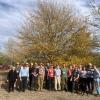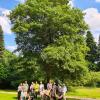Editor's Picks
Plant Focus
Presentation given at the XX International Botanical Conference, Madrid, Spain, July 21–27, 2024.
Authors:
Megan Philpott1, Valerie Pence2
Affiliations:
1. Center for Conservation & Research of Endangered Wildlife (CREW), Cincinnati Zoo & Botanical Garden, Cincinnati, USA
Abstract:
Oaks are flagship species that act as keystones in many communities. However, oaks worldwide are increasingly threatened by novel pests and diseases, habitat loss, and climate change. Protection of global oak biodiversity must include ex situ banking, but as oaks are considered exceptional species overall, they cannot be banked using conventional seed banking methods and instead are best banked long-term using cryopreservation. The first step in developing many cryopreservation protocols is initiation into tissue culture. However, tissue culture propagation in oaks is difficult, with protocol response often specific to species and even genotype. Developing universal tissue culture protocols would make it vastly easier for practitioners worldwide to quickly and effectively bank the biodiversity necessary to ensure these charismatic species survive into the uncertain future. As a beginning step towards this goal we selected eight focal oak species, including six threatened species, from across the United States to study the factors affecting tissue culture initiation in Quercus in preparation for cryopreservation. Eighteen institutions across North America, organized through the Global Conservation Consortium (GCC) for Oak, collaborated to send cuttings from their collections. Using 91 genotypes taken from across the species’ range, we initiated shoot and somatic embryo cultures using a standard experimental protocol to test the effects of species, genotype, climate conditions, anti-microbials, silver thiosulfate, sterilization methods, and other factors in the initiation of Quercus to tissue culture. First year results showed survival at three months across species ranging from 41.3% (Q. rubra) to 1% (Q. boyntonii), with an average survival of 15.7%. Comparison of four new sterilization methods reduced the contamination rate from 73.9% to 18.2%. This project is an example of how the GCC can be used to facilitate large-scale studies on the improvement of ex situ conservation methods. (Research supported by IMLS.)
















